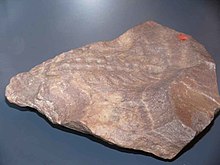Xenusion
This article includes a list of general references, but it lacks sufficient corresponding inline citations. (January 2013) |
| Xenusion auerswaldae Temporal range:
| |
|---|---|

| |
| Scientific classification | |
| Kingdom: | Animalia |
| (unranked): | Panarthropoda |
| Phylum: | †"Lobopodia" |
| Class: | †Xenusia |
| Order: | †Protonychophora |
| Family: | †Xenusiidae |
| Genus: | †Xenusion Pompeckj, 1927 |
| Species: | †X. auerswaldae
|
| Binomial name | |
| †Xenusion auerswaldae Pompeckj, 1927
| |
| Part of a series on |
| The Cambrian explosion |
|---|
 |
Xenusion auerswaldae is an early lobopodian known from two specimens found in glacial debris in Germany.[1] They probably originated in the Kalmarsund Sandstone of Southern Sweden (Jaeger and Martinsson 1966), which was deposited in the Lower Cambrian (Upper Tommotian–Lower Atdabanian; Stages 2→3).[2] The specimens are not especially well preserved. The older specimen is 10 cm or so in length with a narrow, weakly segmented body. A depression runs up the bottom on all but the rearmost segments. There is a slightly bulbous termination, and each segment beyond that seems to have a single pair of tapering annulated legs similar to the modern onychophoran, but without claws. Nine segments are present. There is a spine on each body bump and faint transverse parallel striations on the annulations on the legs. The legs of what is possibly the foremost segments are either missing or not preserved. The head is believed to be missing or is poorly preserved. If Xenusion is an lobopodian, it is one of the oldest currently known fossils of a mobile, modern animal.
It's been said to have a long narrow proboscis, but this is probably a preservational artefact.[3]
Xenusion has been reinterpreted as an Ediacaran frond animal by Tarlo, and a drawing of that interpretation has been presented by McMenamin. Assuming that the creature is actually a lobopodian, the original specimen would appear to be part of an animal about 20 cm in length. In a photograph presented in The Treatise on Invertebrate Paleontology Volume O, the organism's appearance seems to support the original interpretation more. Further studies of Xenusiid close the possibility of a Rangeomorphy affinity.
References[]
- ^ Dzik, J.; Krumbiegel, G. N. (1989). "The oldest 'onychophoran' Xenusion: A link connecting phyla?". Lethaia. 22 (2): 169. doi:10.1111/j.1502-3931.1989.tb01679.x.
- ^ Han, J.; Zhang, Z. -F.; Liu, J. -N. (2008). "A preliminary note on the dispersal of the Cambrian Burgess Shale-type faunas". Gondwana Research. 14: 269. doi:10.1016/j.gr.2007.09.001.
- ^ RAMSKÖLD, L. and CHEN, J.-Y. 1998. Cambrian lobopodians: morphology and phylogeny. In EDGECOMBE, G. D. (ed.) Arthropod Fossils and Phylogeny, Columbia University Press, New York, 107–150 pp.
External links[]
- Xenusia
- Terreneuvian first appearances
- Cambrian Series 2 extinctions